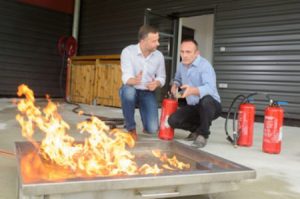 In the event of a fire, the correct use of a portable fire extinguisher could mean the difference between suffering a minor loss or a major one. Portable fire extinguishers, if used properly, can make that difference. But there are several things to consider in using fire extinguishers. For instance, you must know the class of fire involved and the correct type of fire extinguisher to use.
In the event of a fire, the correct use of a portable fire extinguisher could mean the difference between suffering a minor loss or a major one. Portable fire extinguishers, if used properly, can make that difference. But there are several things to consider in using fire extinguishers. For instance, you must know the class of fire involved and the correct type of fire extinguisher to use.
Fire extinguishers can be an important tool in preventing a small fire from growing larger. However, they should not be used to combat large or rapidly spreading fires. The most important thing to do during a fire situation is to get yourself to safety and call the proper authorities to combat the fire.
A building and the property inside are not worth putting yourself or anyone at risk trying to put a fire out with a fire extinguisher.
Classes of Fires and Extinguishers:
Class A: A fire extinguisher labeled with letter “A” is for use on Class A fires. Class A fires those that involve ordinary combustible materials such as cloth, wood, paper, rubber, and many plastics.
Class B: A fire extinguisher labeled with letter “B” is for use on Class B fires. Class B fires involve flammable and combustible liquids such as gasoline, alcohol, diesel oil, oil-based paints, lacquers, etc., and flammable gases.
Class C: A fire extinguisher labeled with letter “C” is for use on Class C fires. Class C fires involve energized electrical equipment.
Class D: A fire extinguisher labeled with letter “D” is for use on Class D fires. Class D fires involve combustible metals such as magnesium, titanium, or sodium.
Class K: A fire extinguisher labeled with letter “K” is for use on Class K fires. Class K fires involve vegetable oils, animal oils, or fats in cooking appliances. This is for commercial kitchens, including those found in restaurants, cafeterias, and caterers.
DON’T DELAY…GET OUT OF FIRE’S WAY!!
Download flyer: STOTW_823_Types of Fire Extinguishers Download Spanish flyer: STOTW_823_Types of Fire Extinguishers_esp

